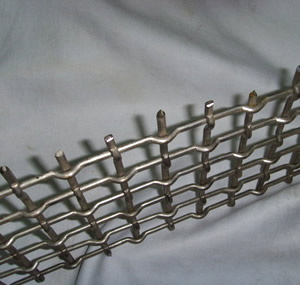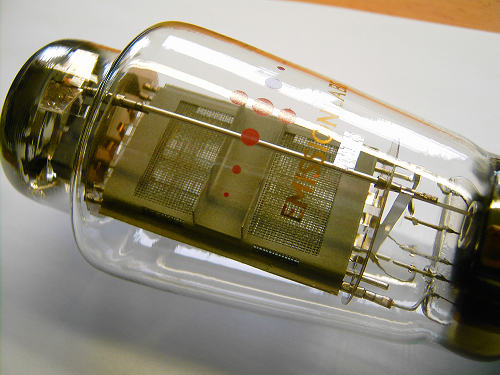EML 300B Mesh
Long Anode version Version
![]() Serious warning for FAKE mesh tubes. Read more about it here
Serious warning for FAKE mesh tubes. Read more about it here
![]() Continue HERE for the data sheet of the only real EML 300B-Mesh
Continue HERE for the data sheet of the only real EML 300B-Mesh
Some information about the 300B Mesh tube.
 The EML 300B Mesh is a wonderful and most amazing tube. The use of this tube requires some care, because it is not a Plug&Play replacement for any 300B. However excellent sound quality is possible with this tube.
The EML 300B Mesh is a wonderful and most amazing tube. The use of this tube requires some care, because it is not a Plug&Play replacement for any 300B. However excellent sound quality is possible with this tube.
With all tubes, there is the balance between best sound and highest output power. There is no way to get both out of a tube at the same time, and 300B is no exception.
For this reason, some 300B amplifiers work at a lower output power, to provide more delicate sound for speakers or applications which do not need output power in the first place. These can be horn speakers, head phones, pre amplifiers, or driver tubes. Some extreme amplifiers produce simply highest possible output power for speakers with low efficiency, up to a level where also tube life gets compromised.
Most normal amplifiers are somewhere in between, and each type has it's own justification. We just need to understand what that justification is.
So We really need to look at how the amplifier design is presented. When we have a 'muscle' type of 300B amplifier, claiming to get so and so many Watt out of a standard 300B tube, it is obvious, what the design compromise here was: High power at the cost of best sound.
By the same idea we have to understand amplifiers which can produce medium output power only, and such which produce only low power. (of course a pre amplifier, or a driver stage with 300B is also a low power application). These give best sound, and compromise in output power. Even the 1925 Western Electric Data sheets of the 300B has clear tables showing these two different ways to use this tube.
The speakers should match the amplifier.
This means, for very high efficiency speakers, it is wrong to operate those with a KT88 amplifier, or 'muscle' kind of 300B amplifier. The high output power is never needed, but at the same time, such an amplifier sounds a bit sterile or dominant at very low power. So to say the tube sound is not really present, because this develops only when there is more output signal on the tube. Such speakers benefit a lot more from a typical low output amplifiers.
However when speaker efficiency is low, a "low power" 300B amplifier would be forced to run at it's maximum. Not only distortion would become audible sooner as you like, but before that, already dynamics and harmonics behavior of the amplifier will suffer. So instead of the more delicate sound, which this amplifier is intended for, the opposite will be achieved. This is why amplifier and speakers should match well, in terms of efficiency.
Please understand we build only the tubes, but the EML 300B-Mesh, which we talk about here, is designed to use in 300B amplifiers of low and medium-low output power only. So it can not be used in any 300B amplifiers with very high output power. (For this, consider plain EML 300B or EML 300B-XLS)
We can not go into more details here about the nature of triode sound, so what is the physical reason behind this much sought after, sweet, silky triode sound. We can say, the best way to achieve this sound, is bias the 300B tube at medium Anode dissipation. (so not at the highest possible). Of course this will give less output power, compared to what is possible at a maximum. So you need to judge for yourself, if this lower output suits your needs.
The finest and sweetest sound has always been produced by the smaller size tubes. To get enough loudness, use speakers chassis with strongest magnets, and you need just a few Watt. In this light, the EML 300B-Mesh has to be seen. It is a tube for listeners that can do with somewhat less loudness, but for that seek more triode-like sound, with the magic and transparency of the wire mesh Anode tubes. If this is what you want, then we much recommend the EML 300B-Mesh.
To replace a 300B by the EML 300B-Mesh, is not possible without some back check. Be sure the wire mesh tube is run at following conditions:
Recommended: 22Wat Anode dissipation.
Absolute maximum: 28 Watt Anode dissipation. Please note, this is a lot less than with standard 300B, which has 40 Watt absolute maximum.
A normal 300B amplifier runs normally at 26....36 Watt plate dissipation. And some abnormal products run it above 36 Watt. Without measurement, you can not know where you are on this scale from 26...36. So suppose it was 26Watt or even less, you could plug&play the EML 300B-Mesh. On the other hand, at 36Watt, this would damage the EML 300B-Mesh in a short time. So this needs very good attention.
Basically there are four kind of Amplifiers:
- Auto bias. To use the EML 300B-Mesh, you need to know how to check the setting, and how to reduce it to 22...28 Watt. This a standard job for a tube technician, he needs no help. But just equipment owners can not do this.
- Adjustable bias. To use EML 300B-Mesh here, simply adjust the plate dissipation for 22Watt. Since adjustable bias is less stabile by itself, it is not recommended to go much above 22 Watt. Some manufacturers have a meter in the 300B amplifier, which provides a reading. Just set this reading (if you can) for 70% of the value, and if possible, 300B-Mesh can be used. Try it out with your 300B first.
- Combined auto bias with adjustable bias. (Mixed Bias) WIth electronics, you can set the desired bias level, and it will be maintained automatically.
- 300B is used as a DRIVER tube, or pre-amp tube. In that case, 300B-Mesh can be used, when the plate dissipation is below 28 Watt. This will normally be the case, but we build tubes, not amplifiers. So check with the amplifier manufacturer for this.
For Auto Bias, like above: When you intend to do the exchange yourself, but have no idea what the above means, do not do it yourself. Have a good technician do it. Do not randomly experiment with the 300B mesh, since there is no guarantee on a burned out tube.
Here is a good hint for any of the cases above: Just do the modification, by using the standard 300B at first. Then when it works, plug in the 300B mesh, and you work a lot safer that way.
In case you have the sound you were looking for, after replacing the 300B by EML 300B-Mesh, but you feel you need a fraction more loudness, the most advised solution is to use loudspeakers with higher efficiency, not use tubes that can be driven harder.
Well... it was a lot of reading... but you made it until here...
Here is a link to the 300B Mesh data sheet:
